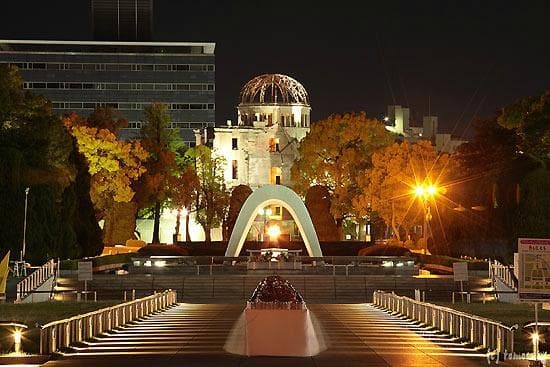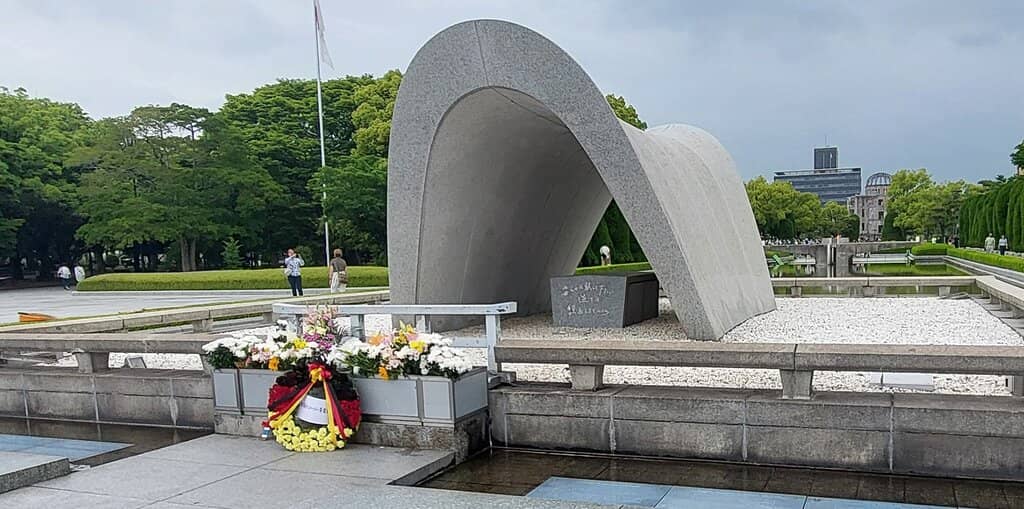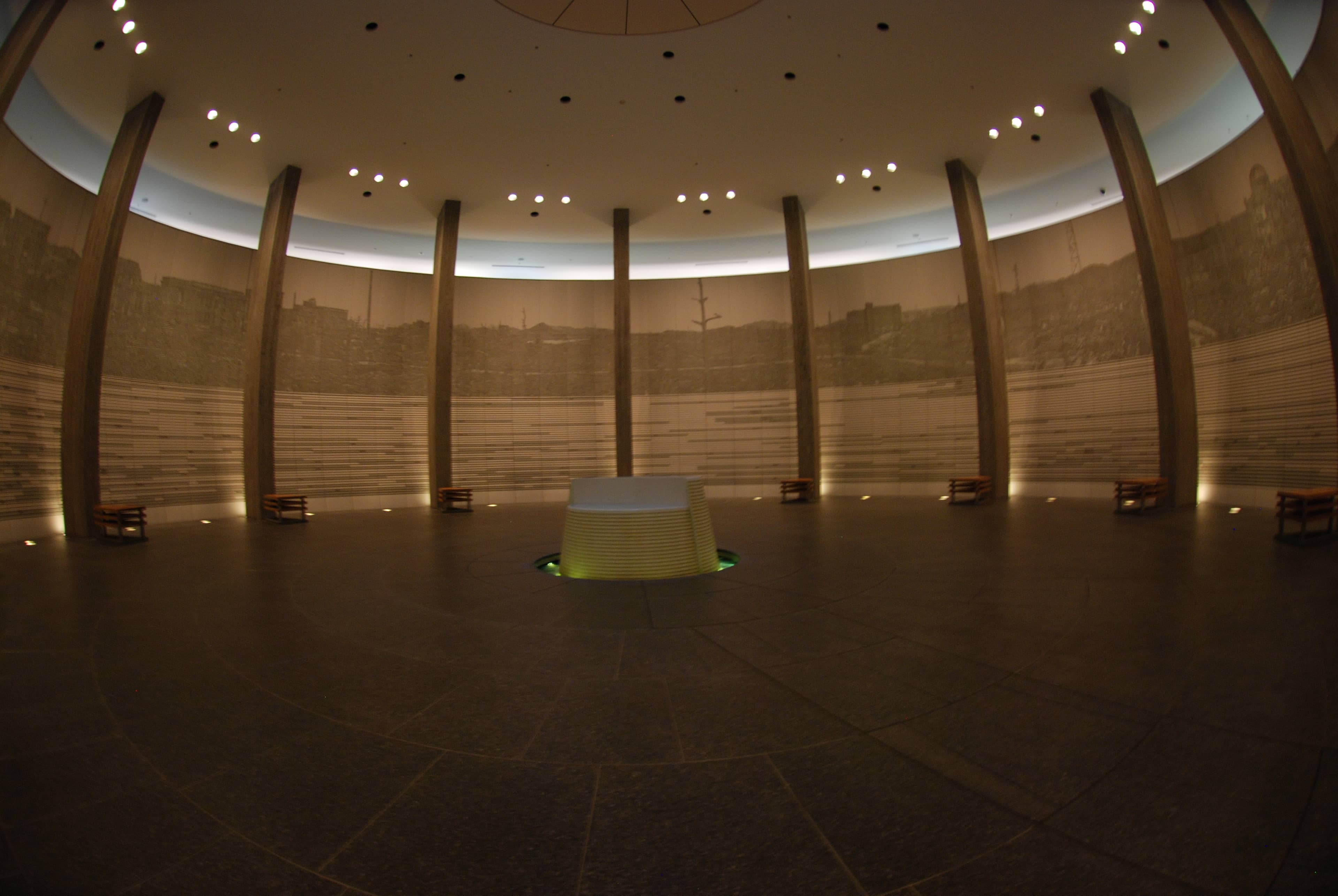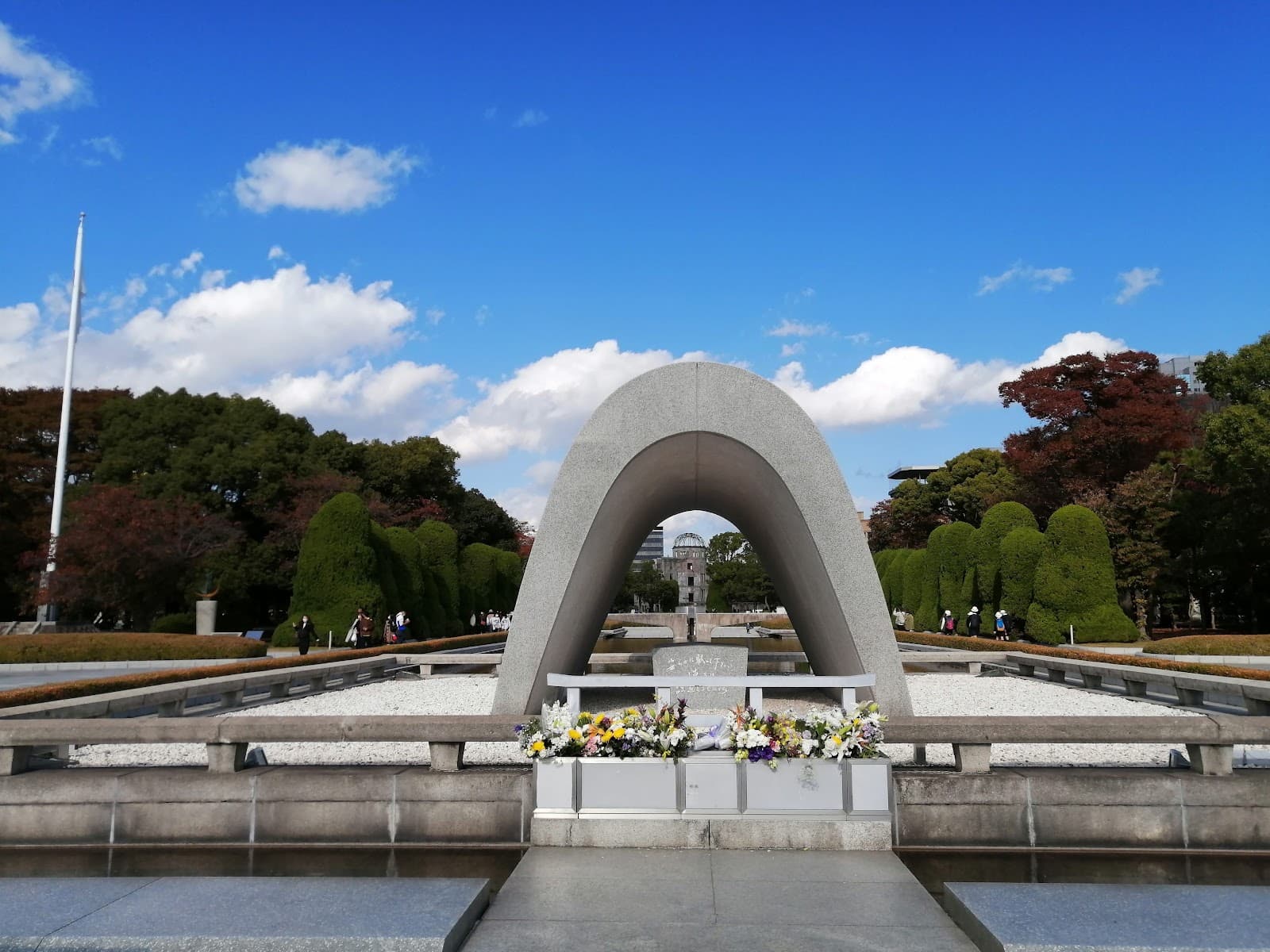
National Peace Memorial Hall for the Atomic Bomb Victims
A solemn memorial dedicated to the victims of the atomic bombing, offering a space for reflection and a powerful message of peace.

Highlights
Must-see attractions

Social
From TikTok & Reddit
Best Time
Fewer crowds, more solemnity

National Peace Memorial Hall for the Atomic Bomb Victims
Best Time
Fewer crowds, more solemnity

Highlights
Must-see attractions
A solemn memorial dedicated to the victims of the atomic bombing, offering a space for reflection and a powerful message of peace.
"A must-visit in Hiroshima, this memorial hall is beautifully designed and leaves a deep emotional impact."

Free Admission
Entry to the memorial hall is free, making it an accessible and essential stop in Hiroshima. :moneywithwings:
Allow Ample Time
Give yourself enough time to absorb the exhibits and reflect. The emotional impact can be profound. :clock1:

Highlights
Discover the most iconic attractions and experiences

Hall of Remembrance
Underground chamber
A breathtaking 360° panorama of Hiroshima post-bombing, created from over 100,000 tiles. A powerful visual testament.

Water Basin
Center of Hall of Remembrance
A symbolic basin representing the thirst of victims, encouraging quiet reflection and remembrance.

Digital Archives & Library
Surrounding chambers
Preserves names, photos, and personal accounts of victims, offering a deeply human connection to history.
Plans like a pro.
Thinks like you
Planning Your Visit
Timing Your Visit for Reflection
Emotional Preparedness
Best Times
Insider Tips
from TikTok, Instagram & Reddit
Free Admission
Entry to the memorial hall is free, making it an accessible and essential stop in Hiroshima. :moneywithwings:
Allow Ample Time
Give yourself enough time to absorb the exhibits and reflect. The emotional impact can be profound. :clock1:
Respectful Demeanor
Maintain a quiet and respectful attitude throughout your visit. This is a place of remembrance. :pray:
Photography is Allowed
While photography is permitted, be mindful of others and the solemn nature of the space. :camerawithflash:
Hiroshima Peace Memorial Park, Hiroshima, Japan - an essential reminder of what matters
Tips
from all over the internet
Free Admission
Entry to the memorial hall is free, making it an accessible and essential stop in Hiroshima. :moneywithwings:
Allow Ample Time
Give yourself enough time to absorb the exhibits and reflect. The emotional impact can be profound. :clock1:
Respectful Demeanor
Maintain a quiet and respectful attitude throughout your visit. This is a place of remembrance. :pray:
Photography is Allowed
While photography is permitted, be mindful of others and the solemn nature of the space. :camerawithflash:
Emotional Impact
Be prepared for a deeply moving and potentially emotional experience. :pleading_face:
What Travellers Say
Reviews Summary
Visitors consistently praise the National Peace Memorial Hall for its beautiful design, profound emotional impact, and educational value. The Hall of Remembrance and its panoramic display are frequently highlighted as particularly moving. While some note it can be crowded, the free admission and solemn atmosphere make it an essential and deeply human experience for understanding Hiroshima's history and the global call for peace.
"This memorial hall is beautifully designed and leaves a deep emotional impact. Located within Hiroshima Peace Memorial Park, it was completed in 2002 as a national tribute to those who lost their lives in the atomic bombing of, 1945.
The architecture is circular and impressive to represent harmony and unity, guiding visitors into a quiet, contemplative space below ground level. As you descend, the environment becomes silent and solemn. The central Hall of Remembrance is powerful, featuring a 360-degree panorama created from tiles that depict Hiroshima just after the bombing, based on photographs taken from the hypocenter.
At the center is a water basin meant to symbolize the countless victims who died crying out for water. The entire space encourages reflection and remembrance without the need for words.
Surrounding the main chamber are digital displays and a library preserving names, photographs, and personal records of victims. It’s a place not just of mourning, but of resolve, to ensure such tragedies never happen again.
This is a must-visit in Hiroshima."
John Winter
"This is the best museum I’ve visited so far. It was crowded in the summer, so it moved very slowly, but still worth a stop. The artifacts left behind from the atomic bomb droppings are mind blowing. So many sad stories. They have a section on the evolution/history of nuclear weapons since Hiroshima as well, which is really good and educational! Very relevant to the world we live in. Like they say, “let’s not have another Hiroshima”. Definitely a must-stop while in Hiroshima!"
Scott Pothier
"A quiet and respectful place for personal reflection. There’s no photography ban, and everyone naturally spends as much time as they feel they need. One interesting detail: the Hall features a 360° panoramic display made from over 100,000 individual tiles recreating the destroyed cityscape as it looked right after the bombing — based on real survivor sketches. Powerful, moving, and deeply human. A must-visit."
Jakub Šesták
What People Like
What People Dislike
Frequently Asked Questions
🚇 🗺️ Getting There
The National Peace Memorial Hall is conveniently located within the Hiroshima Peace Memorial Park. You can reach the park by taking a tram (streetcar) to the 'Genbaku Dome-mae' or 'Hiroshima Peace Memorial Park' stop. From there, it's a short walk. Many visitors also find it easy to access by bus or even on foot if staying nearby.
While there isn't direct parking at the memorial hall itself, there are several paid parking lots available around the Hiroshima Peace Memorial Park. It's often recommended to use public transportation to avoid parking hassles.
It's a considerable walk from Hiroshima Station to the Peace Memorial Park, approximately 20-30 minutes. Taking a tram or bus is generally more efficient and comfortable.
Yes, the Hiroshima Peace Memorial Park is well-signposted, and you should find clear directions to the National Peace Memorial Hall for the Atomic Bomb Victims.
The A-Bomb Dome and the National Peace Memorial Hall are both within the Peace Memorial Park and are easily walkable from each other. It's a very short distance, allowing for a seamless visit to both significant sites.
🎫 🎫 Tickets & Entry
No, the National Peace Memorial Hall for the Atomic Bomb Victims offers free admission. This allows everyone to visit and reflect on the history and its lessons.
The memorial hall is typically open from 8:30 AM to 5:00 PM (or 6:00 PM during peak seasons), but it's always a good idea to check the official website for the most current hours, as they can vary.
Advance booking is not required as admission is free. However, during peak tourist times, the hall can get busy, so arriving earlier in the day is recommended for a more peaceful experience.
The primary restriction is to maintain a quiet and respectful demeanor. Large bags might need to be checked, and photography is allowed but should be done discreetly.
The memorial hall is designed to be accessible. There are facilities for visitors with disabilities, including elevators to access different levels.
🎫 🧭 Onsite Experience
You'll find the Hall of Remembrance with its stunning 360° panorama, a symbolic water basin, and digital archives containing victim memoirs and belongings. The experience is designed for quiet reflection.
Yes, photography is generally permitted inside the memorial hall, but visitors are asked to be respectful and discreet. Avoid flash photography and be mindful of others' experiences.
Most visitors spend between 1 to 2 hours to fully absorb the exhibits and reflect. Some may wish to spend longer, depending on their personal connection to the history.
While there aren't typically formal guided tours within the memorial hall itself, the adjacent Hiroshima Peace Memorial Museum often offers them. Information about the history is also available through exhibits.
The water basin at the center of the Hall of Remembrance symbolizes the countless victims who died crying out for water. It's a poignant reminder of their suffering.
📸 📸 Photography
The Hall of Remembrance's 360° panorama is a key visual, though photography here should be very discreet. The exterior architecture and the surrounding Peace Memorial Park also offer excellent photographic opportunities.
Photography is generally allowed, but always be mindful of the solemn nature of the site. Avoid flash photography and be considerate of other visitors who are there for reflection.
Photos that convey solemnity, remembrance, and the architectural design of the hall, as well as the peaceful atmosphere of the surrounding park, tend to capture its essence.
While photography is permitted, it's best to err on the side of caution and check for any specific signage regarding photos of personal artifacts or displays of victims. Respect is paramount.
Early morning or late afternoon light can be beautiful for exterior shots of the memorial and the park, offering softer light and fewer crowds.
For Different Travelers
Tailored advice for your travel style
👨👩👧 Families with Kids
Consider visiting the broader Peace Memorial Park first, which has more open spaces and less intense exhibits, before entering the Hall of Remembrance. The Hall of Remembrance itself is designed for quiet contemplation, and younger children might find the solemn atmosphere difficult to maintain. If you do visit, focus on the symbolic elements like the water basin and the overarching message of peace.
🤔 Thoughtful Travelers
Take your time to explore the digital archives and personal stories of the victims. These intimate accounts provide a powerful human connection to the historical event. The memorial serves as a potent reminder of the fragility of peace and the ongoing need for global understanding and disarmament.
Deep Dives
In-depth insights and expert knowledge
The Hall of Remembrance: A Visual Chronicle
At the center of this space lies a water basin, a deeply symbolic element. It represents the countless victims who perished from thirst, crying out for water in their final moments. The presence of the water basin encourages visitors to pause, reflect on the immense suffering, and connect with the human cost of the bombing. The entire experience within the Hall of Remembrance is designed to be wordless, allowing the visual and symbolic elements to convey the gravity of the event and foster a personal sense of remembrance.
Beyond the central panorama, the memorial hall houses digital displays and a library dedicated to preserving the memories of those lost. Here, visitors can find names, photographs, and personal accounts of victims, offering a more intimate and individual perspective on the tragedy. This collection serves as a vital archive, ensuring that the stories of the victims are not forgotten and that their experiences continue to educate future generations about the devastating consequences of nuclear warfare.
Lessons from the Past: A Commitment to Peace
Many visitors emphasize the educational value of the memorial, noting how it provides a deeper understanding of the history and the consequences of nuclear weapons. The inclusion of information on the evolution of nuclear weapons since Hiroshima highlights the ongoing relevance of the memorial's message in today's world. It’s a place that prompts critical thinking about global security and the pursuit of a world free from nuclear threats.
The overarching message conveyed by the memorial is one of hope and resolve. While acknowledging the immense tragedy, it also inspires a collective determination to build a more peaceful future. The experience encourages visitors to carry the lessons learned back into their own lives and communities, fostering a global consciousness that prioritizes peace and disarmament.






Social
from TikTok, Instagram & Reddit